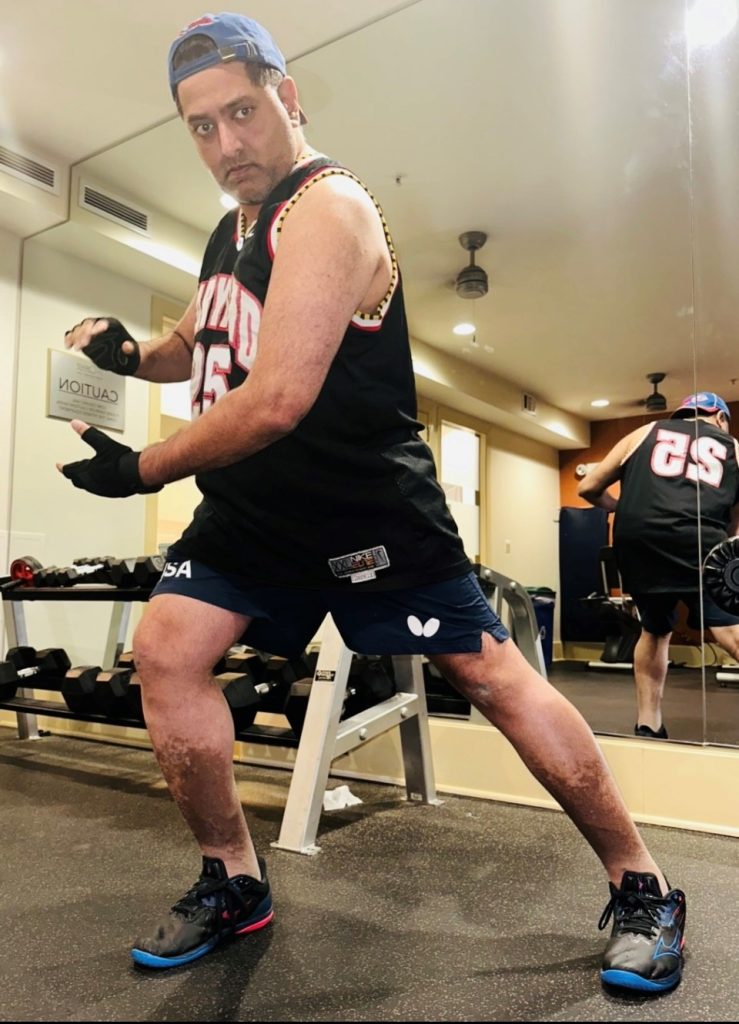Navin isn’t your average person living with Parkinson’s disease. Diagnosed in 2013 at just 39 years old, he has spent over a decade not only learning how to manage the condition, but also how to thrive with it. Now in his early 50s, Navin continues to be resilient. He lives each day with joy and determination, grounded in the belief that Parkinson’s may be part of his life, but it doesn’t control it or keep him from the moments that matter most with his friends, his family, and how he chooses to live each day.
That mindset shows up in everything Navin does. He’s played the violin for more than 40 years and has even performed in a rock band with his electric fiddle. He’s taken up acting and motivational speaking, and created a platform where he shares his story to uplift others and help people see that life doesn’t stop with a diagnosis.
Navin is also a lifelong table tennis player. After his diagnosis, he leaned into the sport even more and noticed something he describes as incredible; his tremors would pause while he played. Demonstrating that effect during speaking engagements often leaves audiences speechless and hopeful.
Like many people living with Parkinson’s, Navin tried several different treatment options over the years. None of the options felt quite right or helped him achieve his treatment goals, until his neurologist suggested he try CREXONT® (carbidopa and levodopa) extended-release capsules.

From the start, Navin noticed a difference. “I’m really happy with CREXONT,” he says. “I had no idea it would be this good.”
He appreciated how smoothly the transition went for him and how an extended-release oral treatment fit better into his lifestyle. With fewer daily doses, he found himself less tied to a strict schedule, which gave him more freedom to focus on the things that mattered most—music, movement, and connection.
“It just fits,” he explains. “It gave me a sense of stability. I didn’t have to think about dosing constantly. That gave me more confidence and motivation to keep going.”
CREXONT is designed to provide a more gradual release of levodopa throughout the day, which may help reduce the ups and downs in blood/plasma concentrations that many patients experience with immediate-release treatments. While every person’s experience is unique, Navin felt like it offered him a smoother path forward.
“I am able to continue to tackle my Parkinson’s straight on, and that made me very happy,” he says.
Navin views his Parkinson’s not as a limitation, but as a launching point. It’s led him to discover new passions, build deeper relationships, and speak up for others who may feel isolated or unsure of what’s ahead.
He’s passionate about helping others see their diagnosis differently. Whether he’s sharing his story on social media, speaking from a stage, or even announcing it over an airplane loudspeaker (yes, really!), Navin’s goal is to let people know they’re not alone and that life after diagnosis is still full of possibility.

“All of humanity is a family,” he says. “We’re all on this journey together. And if I can help someone feel even a little less afraid of the future, then I’ve done what I set out to do.”
Navin’s experience with CREXONT is his own and may not reflect the experience of every patient. For some patients, CREXONT may cause falling asleep during daily activities. Side effects may include nausea and anxiety. Individual results will vary. Talk to your patients to see if CREXONT is right for them. Only an HCP should assess each patient’s condition and advise them on treatment options.
More stories from real patients




